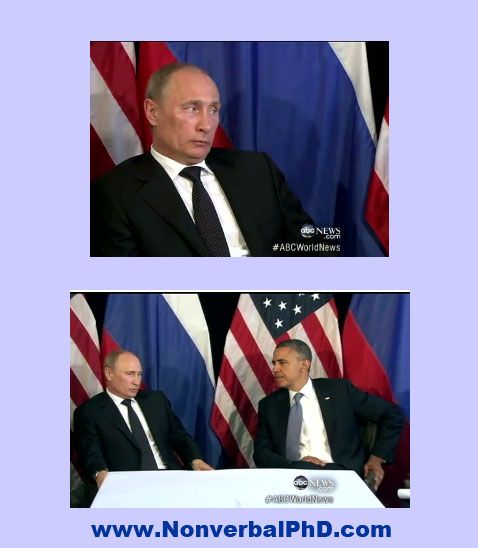Body Language
Presidents Obama & Putin: Body Language Recap
Lots of nonverbal communication provided by each to decode.
Posted June 18, 2012
Here's a quick review of the body language between both American President Obama and Russian President Putin during a G20 Summit meeting in Cancun, Mexico. Firstly, the video was very limiting and I had to rely on what was provided by ABC (US) World News Tonight [watch the segment here]. The short segment is introduced by host Diane Sawyer and she quickly let's us know how much of a role their body language played during their two hour interaction. Specifically, how 'cold' it was.
Have a look at the two photos below:

Working with the limited information and video available, I first reviewed the first photo of President Putin, who reporter, and ABC White House Correspondent, Jack Tapper aptly mentions as not being known as "warm and giggly." Clearly he does not look welcoming. How do I make this inference?
Before I explain below, I want to mention this is the important aspect of decoding nonverbal communication. In order to be effective at encoding and decoding nonverbal communication you must be able to connect the micro traits that represent the macro ones. For this situation the macro trait of building rapport, or more accurately in this case hindering it, is only step one. One must then explore the individual micro nonverbal actions and elements that collectively create the macro trait. This allows a deeper understanding of nonverbal communication.
For President Putin, the micro actions are:
- Leaning away from his counterpart
- His body is not oriented towards President Obama
- His head is not turned towards President Obama. This reduces the ability to make eye contact. The photo shows that his eyes have to turn completely to the side to engage him. Alternatively he could have easily positioned his head and body to more easily make eye contact- if he wanted to.
Now for President Obama:
Tapper mentions towards the end of the segment that eye contact was limited or not existent while I also mention eye contact above. What is all the fuss about eye contact? The fuss is that eye contact is repeatedly mentioned in research as being a nonverbal element that contributes to rapport, immediacy, charisma, and liking. Basically, you engage in eye contact if you want the other person to like you.
Look at the second photograph again and you might be scratching your head as that clearly looks like President Obama is engaging in eye contact but the last thing he seems to be wanting to do is build rapport. There are different types of eye contact. Glancing and gazing contributes to rapport- not "icy" or "cold" staring.
Remember in previous articles I mention how important nonverbal communication clusters are [read here]? How about territorial displays? Here you see President Obama both gripping the arm of the chair and spreading the width of his body. He is expanding his presence territorially- he literally is taking up more space. While his crossed legs might signal being comfortable the incongruence of the other nonverbal channels display anything but a comfortable interaction. Would you grip your chair during a calm and friendly conversation?
Explore a little deeper and it looks like his eyes are squinting, his brows are tense, as well as his mouth is elongated/stretched wider than naturally. If we had a full-faced view, this last element would allow us to see if the mouth elongation is unilateral. If it is, this could be a sign of contempt.
How can you apply this to your life, both professionally and socially?
- Consider How a bad mood or negative emotions can "leak" out if you are intent on building rapport and how that can derail your intentions
- how can you build rapport nonverbally [here's a list of nonverbal actions conencted to rapport];
- Understand importance of eye contact
Rememebr that with eye contact, there is a difference between a 'cold' stare and a 'warm' gaze.
Follow me on twitter to see more pictures and tips on nonverbal communication at @NoverbalPhD.


